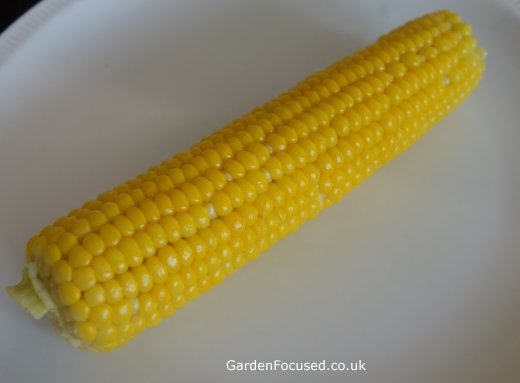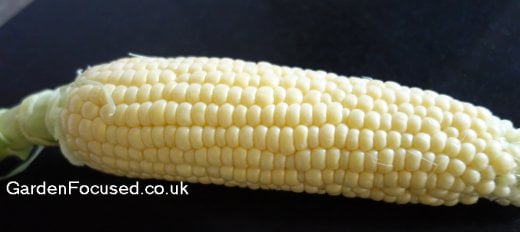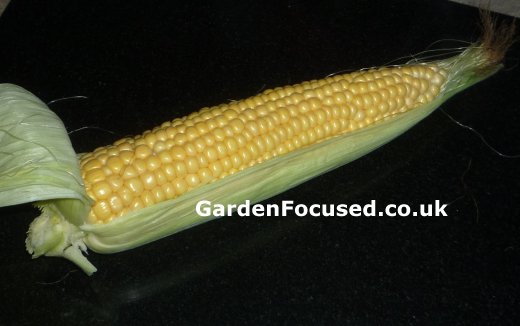Growing sweetcorn in an area exposed to wind can be a big problem so varieties which are relatively low growing can be a great advantage. Below we list those varieties of sweetcorn which we believe are worthwhile for growing in the UK climate and we list their advantages and disadvantages.
Beware of the descriptions given by the seed merchants for sweetcorn, they are almost always very over-optimistic!
CONQUEROR
A well-proven variety which always receives a good deal of support in gardening forums throughout the UK. This is a supersweet variety which produces long cobs in mid to late season. The plants are on the tall side so would need staking in windy sites.
Restrict this variety to one or two cobs per plant and then expect a cob of about 22cm / 9in long. Cobs are generally well-filled and look very attractive.
The RHS reconfirmed their Award of Garden Merit status for Conqueror in 2013. This variety is widely available not only from garden centres but also from online seed suppliers.
EARLIBIRD
A supersweet variety which is true to its name, producing delicious cobs early in the season. One of the best supersweet varieties for the UK climate. One or two cobs are produced per plant and each cob will average 22cm / 9in long.
The RHS reconfirmed their Award of Garden Merit status for Earlibird (initially given in 2003). This variety is widely available not only from garden centres but also from online seed suppliers.
Because Earlibird is a supersweet variety of sweetcorn, it is best not grown with other varieties.
GOLDCREST
A relatively new supersweet variety which has been awarded an AGM byt the RHS in 2016. Our own trials in 2019 found it to be average rather than outstanding. Read our full review of Goldcrest here.

![]()
Sweetcorn variety Goldcrest grown on our allotment
INCREDIBLE
Incredible is a sugar enhanced variety of sweetcorn which is more popular in the US but is still easy to obtain in the UK.
We grew it on our allotment in 2021, not a good year weatherwise for sweetcorn. Normally this is a mid season variety but in 2021 it performed similar to a late variety. Cobs were medium sized, around 20cm / 8in long.
Even though the weather in 2021 was not ideal by any means, each plant produced 2 cobs and I suspect in a more average year three cobs per plant could be realistsic.

![]()
Sweetcorn variety Incredible grown on our allotment
Good, sweet taste and the kernel skins are fairly thin. Not the best looking variety, it lacks the elegant thin looks of some of the others.
LARK
An extra tendersweet variety which has thin tender skins and lots of sweet flavour. Cobs are produced in mid-season. We grew this variety on our West Midlands allotment in 2017 and they reached maturity in late August.
A very reliable and well-proven sweetcorn which tolerates cooler growing conditions. Restrict plants to two cobs and expect a well-filled cob about 20cm / 8in long.

![]()
Sweetcorn Variety Lark grown on our allotment
The RHS reconfirmed their Award of Garden Merit status for Lark sweetcorn in 2016 (initially given in 2003). The final height is around 6ft / 180cm and they withstood a few harsh wind even at that final height on our allotment. We highly recommend this variety, very sweet, tender and tasty.
This variety is widely available not only from garden centres and also from online seed suppliers.
HONEYDEW
Another extra tendersweet variety, this one has the most tender skins of all. Easily capable of producing two, maybe three, good cobs per plant.
MIRAI 003
Supersweet type which normally produces two cobs per plant. Very sweet, reliable performer in the UK weather. This variety has so much going for it that we have produced an individual page for it which can be found here.
Because Mirai 003 is a supersweet variety of sweetcorn, it is best not grown with other varieties.
NORTHERN XTRA SWEET
An extra tendersweet which is well suited to the UK weather even in the North of the country. New varieties however have left it behind as far as flavour and texture are concerned – the skins of the individual kernels are tougher then normal. Not tall so they withstand the the wind better than many.
PRELUDE
If you want a long sweetcorn then prelude is probably the best variety. It’s a supersweet which is an early cropper.
Because Prelude is a supersweet variety of sweetcorn, it is best not grown with other varieties.
SPARROW
Sparrow is an extra tendersweet variety which we trialed in 2018 on our West Midlands allotment. The plant is average height and withstood quite harsh winds during the early summer with only one falling over slightly. We left the fallen sweetcorn to its own devices and it still produced one decent sized cob.
The average length of the cobs were 23cm / 9in with, in almost all cases, all of the individual kernels fully formed. There were very few gaps in the sweetcorn. You can expect between 1 and 2 cobs per plant, the warmer your area the more likely you are to get two cobs per plant.
The variety Sparrow tastes sweet, of that there is no doubt. Individual kernels are slightly larger than normal, which we prefer. They boil to a deep yellow and look exceptionally good on the plate.
It’s slightly difficult to be certain how they grow in cooler areas because the summer of 2018 was exceptionally warm over an extended period of time. Clearly they grow well in warm conditions. The RHS trials of 2016 grew this variety in both Rosemoor (Devon) and Wisley (Surrey) and they were given an AGM. We would agree with that verdict, this is an exceptionally good variety for most of the UK.
One fact became clear from our trials of this variety in 2018 and that concerned the watering requirements of sweetcorn. The summer of 2018, in most areas of the UK, had a very, very low amount of rainfall for three months.
Aside from watering the plants when they were initially planted, we were only able to water the sweetcorn once during that period because of lack of a water supply. These near drought conditions had no effect whatsoever on the sweetcorn – the cobs were still full and juicy.
The probable reason for this lack of need for hand watering was that we mulched the entire sweetcorn bed with 5cm / 2in of woodchip. Whereas other areas of our allotment dried out completely, the soil underneath the mulch remained mainly moist.
A lesson learned for us, it’s clear the roots of sweetcorn are better at extracting moisture from the soil than we thought especially with a good layer of mulch.
SWIFT
One of our favourites for no reason other than reliability and superb sweet taste. Cobs are about 22cm / 9in long and well filled with straight rows. Swift is an extra tendersweet variety.
We trialed this variety on our allotment in 2018. The skins on the kernels is one of the thinnest of all. Expect two cobs on most plants early in the season and well suited to the UK climate. Slightly shorter than average so withstands windy conditions well.
One problem that has been reported with this variety is that large amounts of the seeds fail to germinate. For this reason, read carefully the advice we give about sowing sweetcorn seeds which can be found here.
Our own personal experience concerning germination of this variety is good. Originally given an RHS Award of Garden Merit in 2003, this was reconfirmed in 2012.
Sometimes our readers ask specific questions which are not covered in the main article above. Our new
Sweetcorn comment / question and answer page
lists those comments, questions and answers. At the end of that page there is also a form for you to submit any new question or comment you have.


Growing Sweetcorn
When and How to Sow Sweetcorn
Ongoing Sweetcorn Care
Pests and Diseases
Recommended Sweetcorn Varieties
Comments, Questions and Answers
RECOMMENDED SWEETCORN VARIETIES
By David Marks
As well as the three different types of sweetcorn there are also many different varieties bred to satisfy the needs of different types of gardeners. The key difference between the varieties is probably the speed at which they mature. But that’s not the only difference. The size of the cob is another factor and the vigour of the plant. Another key factor for many gardeners is the eventual height of the plant.